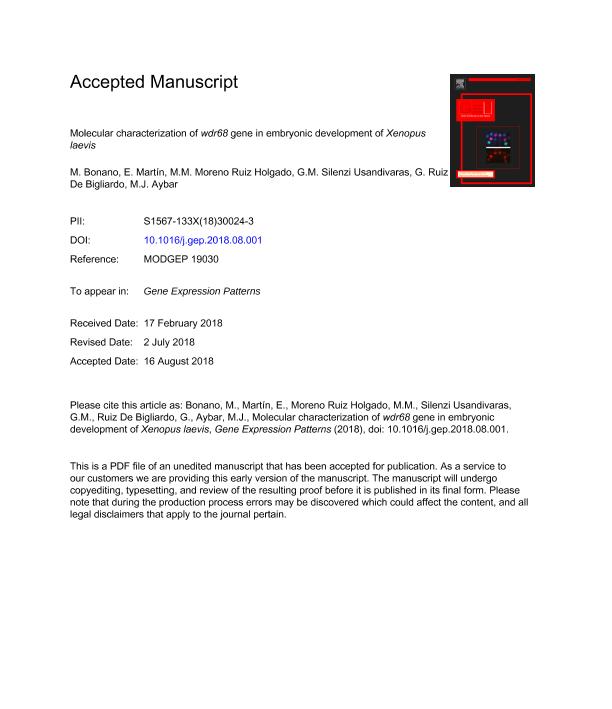Mostrar el registro sencillo del ítem
dc.contributor.author
Bonano, Marcela

dc.contributor.author
Martín, Eduardo
dc.contributor.author
Moreno Ruiz Holgado, Maria Macarena

dc.contributor.author
Silenzi Usandivaras, Gabriela María
dc.contributor.author
Ruiz de Bigliardo, Graciela
dc.contributor.author
Aybar, Manuel Javier

dc.date.available
2019-10-18T19:30:57Z
dc.date.issued
2018-08
dc.identifier.citation
Bonano, Marcela; Martín, Eduardo; Moreno Ruiz Holgado, Maria Macarena; Silenzi Usandivaras, Gabriela María ; Ruiz de Bigliardo, Graciela ; et al.; Molecular characterization of wdr68 gene in embryonic development of Xenopus laevis; Elsevier Science; Gene Expression Patterns; 30; 8-2018; 55-63
dc.identifier.issn
1567-133X
dc.identifier.uri
http://hdl.handle.net/11336/86472
dc.description.abstract
WDR68, also known as DCAF7, is a WD40 repeated domain protein highly conserved in eukaryotic organisms in both plants and animals. This protein participates in numerous cellular processes and exerts its function through interactionwith other proteins. In the present work, we isolated, sequenced and characterized cDNA corresponding to the wdr68 gene in embryos of the amphibian Xenopus laevis. Syntenic analysis revealed high conservation of the genomicregion containing the WDR68 locus in amniotes. Nevertheless, in fishes and amphibians, we observed that the tandem genes surrounding wdr68 undergoes certain rearrangements with respect to the organization found in amniotes. We also defined the temporal and spatial expression pattern of the wdr68 gene in the development of Xenopus laevis through whole mount in situ hybridization and RT-PCR techniques. We observed that wdr68 is ubiquitously expressed during early embryonic development but, during the neurula stage, it undergoes a strong expression in the neural tube and in the migratory cephalic streams of the neural crest. At the tailbud stages, it is strongly expressed in the cephalic region, particularly in otic and optic vesicles, in addition to branchial arches. In contrast, wdr68 transcripts are localized in the somitic mesoderm in the trunk. The expression area that includes the migratory neural crest of the head and the branchial arches suggest that this gene would be involved in jaws formation, probably through a hierarchical relationship with the component genes of the endothelin-1/endothelin receptor type A cell signaling pathway.
dc.format
application/pdf
dc.language.iso
eng
dc.publisher
Elsevier Science

dc.rights
info:eu-repo/semantics/openAccess
dc.rights.uri
https://creativecommons.org/licenses/by-nc-sa/2.5/ar/
dc.subject
ENDOTHELIN
dc.subject
CELL SPECIFICATION
dc.subject
EMBRYO
dc.subject
NEURAL CREST
dc.subject
CELL DIFFERENTIATION
dc.subject
GENE EXPRESSION
dc.subject.classification
Biología del Desarrollo

dc.subject.classification
Ciencias Biológicas

dc.subject.classification
CIENCIAS NATURALES Y EXACTAS

dc.title
Molecular characterization of wdr68 gene in embryonic development of Xenopus laevis
dc.type
info:eu-repo/semantics/article
dc.type
info:ar-repo/semantics/artículo
dc.type
info:eu-repo/semantics/publishedVersion
dc.date.updated
2019-10-16T19:13:38Z
dc.journal.volume
30
dc.journal.pagination
55-63
dc.journal.pais
Países Bajos

dc.journal.ciudad
Amsterdam
dc.description.fil
Fil: Bonano, Marcela. Consejo Nacional de Investigaciones Científicas y Técnicas. Centro Científico Tecnológico Conicet - Tucumán. Instituto Superior de Investigaciones Biológicas. Universidad Nacional de Tucumán. Instituto Superior de Investigaciones Biológicas; Argentina
dc.description.fil
Fil: Martín, Eduardo. Universidad Nacional de Tucumán. Facultad de Ciencias Naturales e Instituto Miguel Lillo; Argentina
dc.description.fil
Fil: Moreno Ruiz Holgado, Maria Macarena. Universidad Nacional de Tucumán. Facultad de Ciencias Naturales e Instituto Miguel Lillo; Argentina. Consejo Nacional de Investigaciones Científicas y Técnicas. Centro Científico Tecnológico - Tucumán. Unidad Ejecutora Lillo; Argentina
dc.description.fil
Fil: Silenzi Usandivaras, Gabriela María. Universidad Nacional de Tucumán. Facultad de Ciencias Naturales e Instituto Miguel Lillo; Argentina
dc.description.fil
Fil: Ruiz de Bigliardo, Graciela. Universidad Nacional de Tucumán. Facultad de Ciencias Naturales e Instituto Miguel Lillo; Argentina
dc.description.fil
Fil: Aybar, Manuel Javier. Consejo Nacional de Investigaciones Científicas y Técnicas. Centro Científico Tecnológico Conicet - Tucumán. Instituto Superior de Investigaciones Biológicas. Universidad Nacional de Tucumán. Instituto Superior de Investigaciones Biológicas; Argentina
dc.journal.title
Gene Expression Patterns

dc.relation.alternativeid
info:eu-repo/semantics/altIdentifier/url/https://doi.org/10.1016/j.gep.2018.08.001
dc.relation.alternativeid
info:eu-repo/semantics/altIdentifier/url/https://www.sciencedirect.com/science/article/pii/S1567133X18300243?via%3Dihub
Archivos asociados
